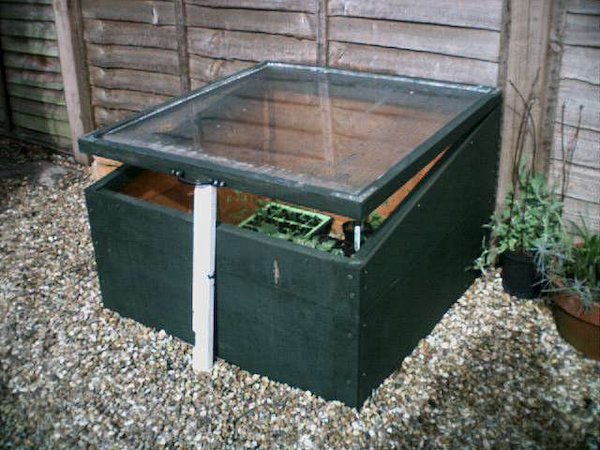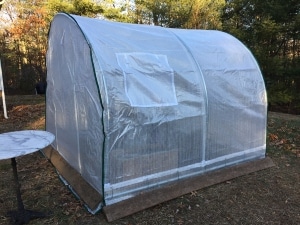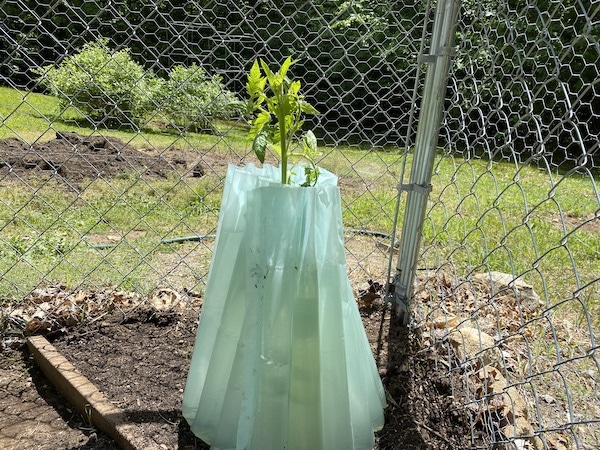Cold frame kits make it easy to extend the growing season in your garden. They’re an inexpensive way to start your seedlings or grow lettuce when it’s below freezing or keep growing herbs after the growing season has ended.
Best of all, you don’t need to have any carpentry skills to add a cold frame kit to your patio or your garden bed. They are easy to assemble and inexpensive.
For these reasons, cold frame kits have become hugely popular with backyard gardeners and hobby farmers who want to grow better food for their dinner tables.
Plus, you’ll be glad to know that there are a lot of kits available at a variety of different price ranges. So there’s really no reason not to have one if you want to grow vegetables longer and more successfully.
Let’s take a sec to get the legal words out of the way. This article may contain affiliate links. That means if you click and buy from my partners, I will make a tiny amount of money. This in no way affects my recommendations.
This article reviews the one I bought plus two others that I considered when shopping for my kit.
Table of Contents
This is a long, detailed article. You can jump to where you want to be by clicking on the different sections below. To come back to this table of contents, just use the back button on your browser.

Cold frame kits and protected culture
Using cold frames or other season extending devices has become so popular that people are using a new term to describe it: protected culture.
What is protected culture?
You already know about “agriculture” and “aquaculture.” Increasingly, weekend gardeners practice “permaculture.”
Similarly, protected culture refers to a type of plant growing. It means using season extending techniques, for example, cold frames, hoop house kits, polytunnels, high tunnels, greenhouses, etc. to grow plants in environments that are protected from the elements.
Why has it become popular? Protected culture has great advantages for the backyard grower:
- Winter — no bugs to bother you or eat your plants
- Fewer wild animals to dig up or chomp down on your vegetables
- Lower temperature means less watering
- Longer growing season means more and better results
While there are many options for working with protected culture in your backyard, cold frame kits are the most popular.
One of the main reasons is because building a structure that (1) looks decent, (2) won’t collapse in the snow or (3) won’t blow away in the wind is not easy for some people. But a cold frame kit makes it easy.
No carpentry skills needed
One of the biggest requirements that I had when I went shopping for a kit was it had to be easy to assemble. A kit that you can assemble in 15 minutes was high on my list of must haves.
The one I selected featured “no-tools-required assembly.” That’s a good indicator of how easy it was to assemble. Still, it did require hand tools. The manufacturer wasn’t exactly truthful.
Another disappointment is some of the screw holes didn’t perfectly line up. I had to use a little muscle to make it work.
A big requirement was sturdiness. Many years ago I purchased an all plastic cold frame that was made of material that quickly broke down due to sun and cold.
I didn’t want that to happen again, so I selected one with a wood frame and polycarbonate panels.
Review of the Giantex kit
One of the things that is really nice about the Giantex kit (the one I bought) is that it’s very solid. The frame is made of fir (a type of hardwood) and the panels are made of polycarbonate.
Polycarbonate panels insulate about as good as glass, but they aren’t as heavy and won’t break as easily.
The top panel has hinges as you would expect from a cold frame. This allows you to easily open the top when there’s too much heat. The hinge bolt locks into place so you don’t have to prop it open with a stick.
I really like the fact that you can take it apart easily and reassemble it in another location. I move mine around frequently. So this is important to me.
You have to be sure that you remember to prop open the lid when it’s very sunny because a small space like this will heat up to temperatures that will fry your plants.
For more info, including pricing, click here.
Here are the details on the two other kits I considered:
ShelterLogic round raised bed cover

| Covering | Triple layer, heat bonded |
| Hoops | Tubular frame |
| Other | Zippered door |
| Shipping | Free |
| Not provided | Base panels |
| More info | Click here |
| Price | Click here |
Zenport cold frame

| Panels | Polycarbonate |
| Frame | Aluminum |
| Other | Folds flat for storage |
| Shipping | Free with Prime |
| More info | Click here |
| Price | Click here |
Cold frame kits FAQ
The purpose of a cold frame is to allow gardeners to start growing earlier in the year and extend the growing season as much as six weeks when the weather turns cold. You can even grow some cold hardy vegetables when there’s snow.
Yes, you don’t need a kit to make a cold frame. In fact, a home made cold frame is an excellent project for a DIY handy person. A great tutorial for making a cold frame is available at https://www.youtube.com/watch?v=m2PJP5OJO0E&feature=emb_logo.
A floor will prevent you from growing your plants directly in the ground. I frequently plant seedlings in a cold frame while it is still cold outside. The cold frame protects the warm weather plants from the cold until the weather turns warm. I remove the cold frame when it’s no longer needed. This helps me get a head start on the growing season, allowing my plants to establish themselves before harmful insects arrive on the scene.
Protected culture is when gardeners or farmers use techniques to protect plants from the elements. Protected culture techniques include hoop houses, high tunnels, low tunnels, row covers, cold frames, poly tunnels and more. Like agriculture, aquaculture, permaculture, etc., it’s a way to grow plants. Sometimes I use a cold frame inside a hoop house for double protected culture. This gives you a more significant temperature boost and allows you to start even earlier.
A well-constructed cold frame kit for your garden will cost about $90. This is a worthwhile expense because you will be able to start growing earlier and maybe even grow cold hardy vegetables all year even where winters are cold.
A cold frame is typically much smaller than a greenhouse. You’re not able to get inside a cold frame because they sit low to the ground. There’s only enough room for small plants. A greenhouse, on the other hand, is typically large enough for shelves and a walk way. Larger greenhouses are permanent structures and often have heating systems.
Typically, the only source of heat in a cold frame is the sun. The cover traps the sun’s warmth inside the small structure. It doesn’t take a lot of sun to heat the air and soil in a cold frame. However, the environment inside a cold frame will drop below freezing during sustained cold temperatures. This is especially true on cloudy days and at night.
Where it’s cold in the winter, backyard gardeners use cold frames to extend the growing season and otherwise protect vegetable plants from the elements. You can harden off seedlings in a cold frame or grow lettuce in the winter or dig carrots even when there’s snow on the ground.
It’s easier to keep plants warm in a cold frame because the area inside is typically smaller and the sun heats it up quickly. Of course, greenhouses or hoop houses have more space. Often, they allow you to walk in and tend to your plants. But with more space comes a higher cost. Even inexpensive hoop house kits cost at least twice as much as a cold frame kit.
The most popular vegetables that gardeners grow in cold frames are salad greens. If you time it right, you can grow lettuce and other cold weather greens deep into the winter (maybe even all winter). Some people overwinter carrots in a cold frame. I have started tomato and cucumber plants early in the spring in a cold frame. Then I remove it when the danger of cooler temperatures is past. This makes it possible to establish warmth loving plants earlier in the year. It’s a real advantage if you can get a jump on the growing season. But you don’t have to grow only vegetables in a cold frame, many gardeners grow cold hardy flowers in cold frames in the early spring, winter and fall.
Most of the time there is no need for external heat for plants grown in a cold frame. In fact, the real danger, even in the cold of winter, is frying the plants on sunny days. Temperatures in a cold frame can easily reach 90+ degrees Fahrenheit on sunny days. So remember to vent the cold frame when needed. Plants with immature root systems are especially susceptible to heat. If you need additional warmth on cold nights, you may want to try a candle. (But be careful not to let the fire get out of hand.) On the other hand, some people use an electric heating element to warm the plants.
Walls of water, also called water teepees, are used to protect warmth loving plants from colder temperatures. Unlike a cold frame, a wall of water uses water as an insulator. Often, backyard tomato or pepper growers use walls of water to keep their plants warm in the spring time. But you can only fit one plant in a wall of water. Cold frames, on the other hand, create a warmer environment for groups of plants and use glass, polycarbonate or other plastics as a barrier to the elements.
Yes many backyard gardeners grow cold hardy plants throughout winter. These plants include spinach, lettuce and endive. But you wouldn’t want to grow warmth loving plants in a cold frame in winter. The temperatures get too cold, and there isn’t enough light.
Yes cold frames are built to withstand heavy snow. The snow will even insulate the cold frame and help to keep the plants warm. However, you will need to clean off the top of the cold frame so that light can penetrate inside it.
You don’t need artificial lights for a cold frame. One of the big benefits of starting seedlings in a cold frame is that, during the day, it’s warm enough even when it’s cold outside. This allows you to take advantage of the sun’s powerful light.
Homemade cold frames can be very heavy and bulky. This is especially true if the cover is made of glass. Cold frame kits that use polycarbonate panels are typically easier to move. Some kits even allow you to take them apart for storage. This is an important consideration if you plan to store them during the warm season.
Many vegetable plants grow better in a highly humid environment. A cold frame captures both heat and humidity. This makes for an improved growing environment for humidity loving plants.
Hardening off allows your plants to adjust to the increased amounts of wind, light and cold in the great outdoors. Many gardeners use a cold frame as a kind of halfway house for their seedlings. By putting seedlings in a cold frame before you put them completely outside, you help get them use to temperature fluctuations and bright sunlight before they get the full exposure to outdoor elements. This helps gradually get them ready for transplanting in your garden.
Related articles you might enjoy:
- A Hoop House is a Tomato Growing Machine
- Growing Lettuce in Winter
- Grow A Million Cucumbers in a Hoop House
Suburban Hobby Farmer is a participant in the Amazon Services LLC Associates Program, an affiliate advertising program designed to provide a means for sites to earn advertising fees by advertising and linking to amazon.com.


